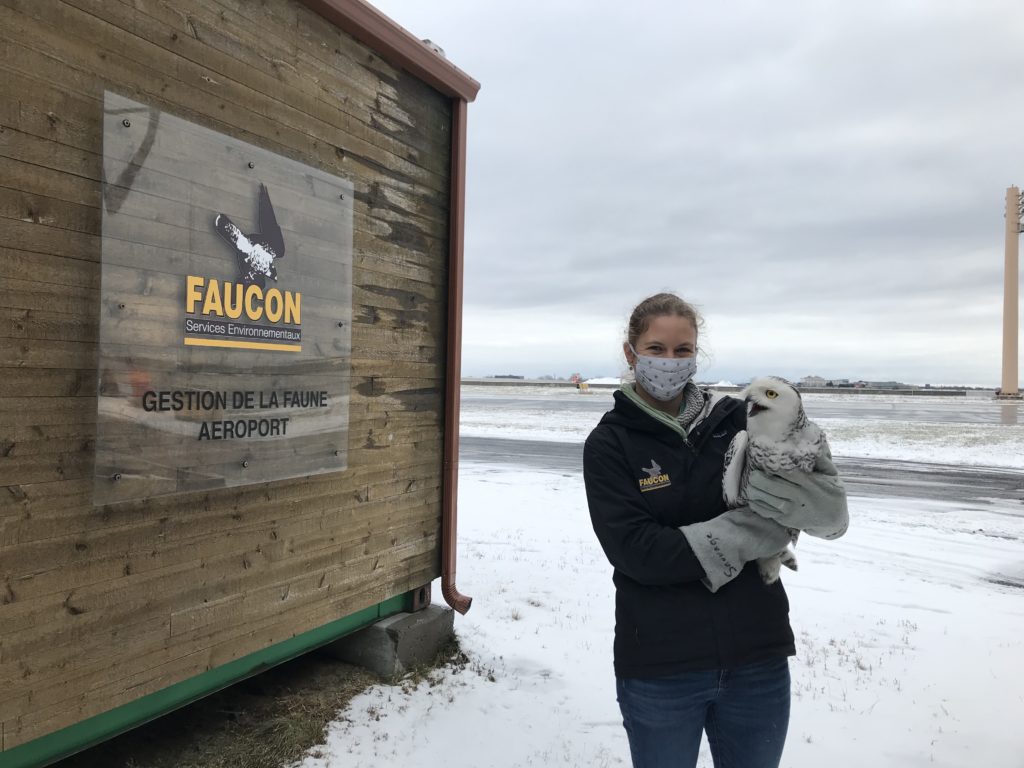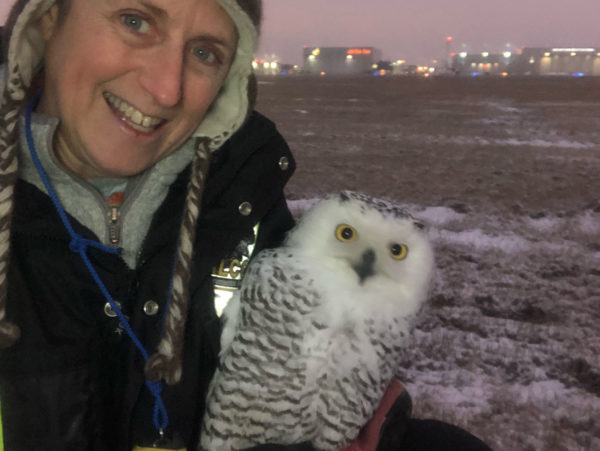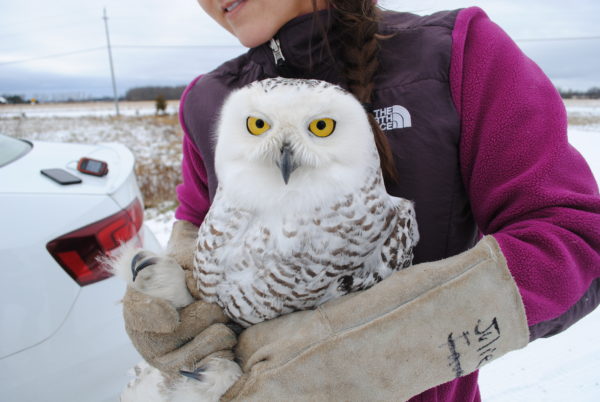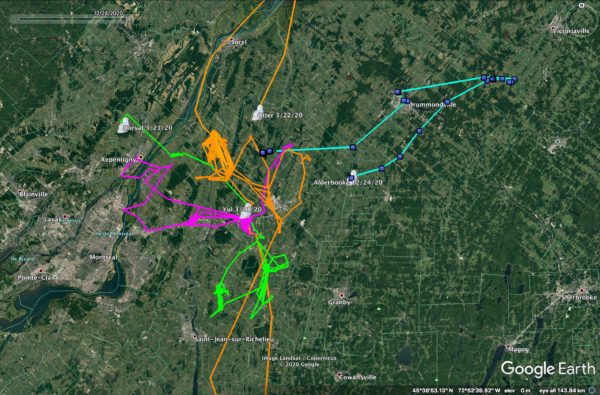
Marilou Skelling of Falcon Environmental, preparing to fit Alderbrooke with a transmitter. (©Rebecca McCabe)
We’re pleased to announce the first newly tagged owl of the season — a heavily marked juvenile female we’ve nicknamed Alderbrooke, trapped and relocated from the Montréal airport.

Julie Lecours of Falcon Environmental with Alderbrooke, just after catching the owl for the first time at the Montréal airport. (©ulie Lecour)
Trapped and relocated twice, in fact; much as with Dorval last year, Alderbrooke as proven to be a persistent boomerang. She was initially trapped Dec. 9 by Julie Lecours of Falcon Environmental, which provides wildlife services at the airport, and with whom we have been collaborating to study the behavior of relocated airfield owls.
Alderbrooke was tagged by Rebecca McCabe, our Ph.D. candidate at McGill University who is using SNOWstorm’s immense dataset to answer a lot of questions about the winter movement ecology of snowy owls — including best practices for moving them from airports so they stay moved. (Becca’s work is partially funded by Bird Protection Québec, and Alderbrooke is named in honor of one of that organization’s sanctuaries.)

Alderbrooke, tagged and ready to go, with Becca McCabe. (©Rebecca McCabe)
Once she had tagged Alderbrooke, Becca moved the owl to one of her predetermined release sites, chosen for varying distances, directions and quality of habitat as part of the relocation study. This one was near Glen Robertson, Ontario, 60 km (37 miles) to the west of the airport. Becca said she was hopeful Alderbrooke would settle down there, since she saw other rodent-specialist raptors, including a rough-legged hawk, hunting the area.
Alderbrooke had other ideas. She beelined back to the airport Dec. 14, and took a few more days for FE biologists to catch her a second time, on Dec. 19. She was in good shape, and the same weight as when she was originally trapped. This time Becca took her across the St. Lawrence to Chouette à voir, in Saint-Jude, Québec, about 70 km (43 miles) east-northeast of the airport — the same farming area where Dorval, Otter and Yul wintered last year.

Alderbrooke’s first relocation, left, into Ontario, and her second on the right across the St. Lawrence. (©Project SNOWstorm and Google Earth)

An overlay of Alderbrooke’s lastest tracks in blue, along with last winter’s movements by Dorval (green), Yul (purple) and Otter (orange). (©Project SNOWstorm and Google Earth)
This time, it seems to be working. At her last transmission on Dec. 24, Alderbrooke had made an 80-km (47-mile) exploratory flight east, then doubled back about half way to near Upton, QC. We’ll have an interactive map for her ready in a few days, and we’ll post to social media when it goes up.
By the way, there was a recent question in the blog comments about how snowy owls are trapped. There are a couple of methods we routinely use. Alderbrooke was originally caught using a bownet, which is basically a giant, spring-loaded net, usually circular, about four feet wide and hinged in the middle. A small cage with a pigeon, hamster or gerbil is placed in the center for a lure. Bownets are the bread-and-butter trap for biologists who catch large raptors.

Alderbrooke checks out her new digs after her second relocation. (©Rebecca McCabe)
When she was retrapped, it was using a different technique known as a verbail trap — a gizmo that affixes to the top of a short post. When the owl lands on the post (attracted by a caged lure animal at its base), the trap harmlessly snugs a soft cord around both legs above the feet, sliding the owl to the ground for a few moments until the bander arrives. Many banders also use some version of a bal-chatri or phai trap, ancient designs originally incorporating horsehair nooses around a caged lure, but today using heavy monofilament or braided nylon fishing line to hold the owl’s foot as it reaches for the caged lure. All are safe and have been used for — well, for centuries, to trap wild raptors.


7 Comments on “Alderbrooke”
My favorite sentence: Alderbrooke (h)as proven to be a persistent boomerang…
Thanks for letting us in on your owlspeak! Stay in the new spot, Alderbrooke! I love the dual service of removing owls from airports for the safety of all, AND getting data sets at the same time.
You noticed the fact that my laptop’s “h” key is balky — thanks for correcting my typo, Julie!
Alderbrooke stop trying to hitch a ride to some unknown parts of the world. Stay in Canada much safer. Love her name.
Thank you so much for the catch band and release info! That’s so cool. Someone had to figure out how to do this and safely and it’s fascinating how efficient it is and doesn’t bother the owls. Now if you’ll excuse me, I’m off to have a second glass of wine, close my eyes and pretend I’m Becca holding AlderB. #AgirlCanDream
Nice to be living in an age where we have this great technology to study the movements of these wonderful birds!
Welcome to the family Alderbrooke!! Hope you stay in the new spot. Thanks for the update Scott.
Thanks for the fast lesson on owl traps, I’ve often wondered ( and worried) about how these big birds were captured. Stay safe, Alderbrooke!